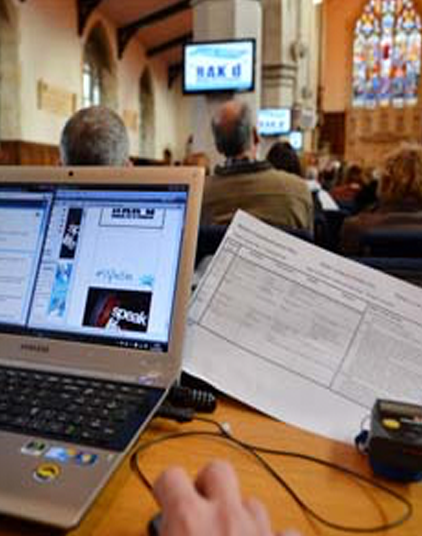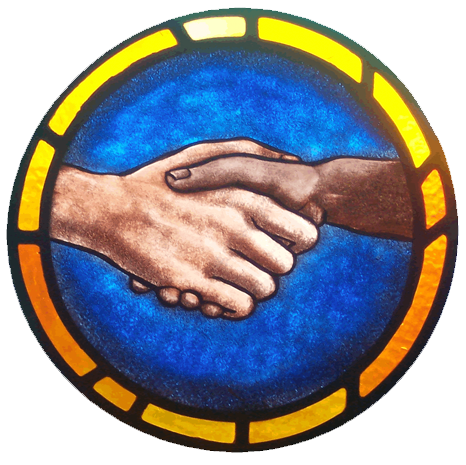
Inviting People into a Relationship with Jesus Christ
There are many, many strategies for making new disciples of Jesus Christ, but they all come down to the same thing, inviting people into a relationship with Jesus Christ. That’s it. It’s not bashing people over the head with Bibles or threatening them with hell. Bibles are not for bashing and you are not God. But you can be a part of bringing healing, hope, and joy to people’s lives, and the promise of a love that does not end and a mercy that can even conquer death.
Still, most of us feel inadequate when it comes to inviting people into that relationship with Jesus, so training and programming can help members of your congregation to become more effective evangelists. There are all sorts of statistics about Lutherans and evangelism, including one that says a Lutheran invites someone to church once every 15 to 20 years. With some encouragement and a little education, we’re betting we can all do better than that. The following programs and ideas may help provide enough support and education to get people to get up and share their love of Jesus. They are organized loosely by their approach.
Digital Evangelism
It is increasingly impossible to do evangelism without a digital presence. Facebook, websites, and other online resources or forms of outreach are both necessary to ensure that your congregation is not “dark” to the world and can be found by people who are looking to more firmly establish their relationship with Jesus Christ and his Church. Facebook is a good start, but the kinds of information people need to know about your church before they walk into the front door is hard to maintain on Facebook. Facebook is really more about the experiences people have and not the sort of information newcomers need to find your church and its worship times. Websites are expensive for small churches, but check back with the Communications Team of the NALC soon. They hope to have a low cost or NO cost version of a website available soon for congregations without their own resources to order or to maintain websites. Two more expensive tiers of service may be included for congregations wanting to actively use their websites to reach out to their communities. Keep checking thenalc.org for more information concerning the start date for this new service.

Larger churches may be able to afford having a website built for them from scratch. Congregations of more moderate means now have many options in terms of companies that offer relatively inexpensive templates into which they can plug in logos, content like worship times and a map showing where the church is, photos of church members at worship or fellowship. Outreach, Sharefaith, Faith Connector are just a few of the companies with a proven track record for providing an inexpensive website.
Digital Dos and Don’ts
There is all sorts of information available online or in books about best practices on digital platforms. Platform is just a fancy way of saying media, but it is one of those words you will run into if you have not already.
Tips

Your primary goal as you build a digital presence in the community is that people looking for a place to meet God in worship and fellowship can find your church, its location, the time and days of worship, contact staff, and get pertinent information about events, membership, and your church’s beliefs and practices. Keep it as simple as possible, while doing your best to present your church in an inviting light.
Planning

Make sure before you get to much into the details, that you sit down with members of your church council or communications team and outline what you need in your digital presence. Spend a couple of hours online looking at church websites and noting what you like and what you don’t like. Choose the means by which you will get the website built, and then start on its content.
Usability

Do please do all you can to make your website readable, organized well, and up-to-date. Google, and other online search engines encourage sites to have a mobile-friendly site to conform to multiple screen sizes. Having a logical path to follow and a good solid structure allows users to navigate your church’s website with ease. Even very old people are now web savvy, and there is nothing more irritating than being unable to read the content on a page.

Hospitality Evangelism
When someone comes to your home, you can choose to let them in or turn them away. Sometimes we stand on the doorstep, and while we might actually let someone in the door our attitude makes it pretty clear that we don’t really want them in our house. That is understandable when the person who rang your doorbell is a vacuum cleaner salesman, but it is a disaster when it is a visitor to your church.
Welcome visitors are received like visiting royalty. We take their coats, escort them to the best chair in the house, get them a glass of water or lemonade and put a few cookies on a plate. Then we sit down with them and visit with them in a way that lets them know we are blessed by their presence in our home. When visitors come to church, we should do very much the same thing. Show them where to put their coats, where the restrooms are, give them a bulletin, answer any questions they might have, and introduce them to other people around them. If they have children, introduce them to families with other children or the nursery staff or Sunday School teachers. When they leave, they should know that you feel that you have been blessed by their presence in this house of God.
Hospitality is fundamental to our faith. The baptized are brothers and sisters in Christ no matter where they come from or what they look like. Any visitor to the church, then, is potentially a family visit, a coming home of a sibling much beloved by our heavenly Father and his Son, our Lord Jesus Christ. For this reason, the Church has always practiced a graceful hospitality, knowing that not only do we welcome our God’s beloved children home, but that we might also be welcoming “angels, unaware” (Hebrews 13:1-2).
There are hundreds if not thousands of resources on hospitality evangelism. A few of those resources are listed below.
- The Welcoming Congregation: The Roots and Fruits of Christian Hospitality, Brinton and Willimon, 2012
Available online at: Christian Books | Amazon - Widening the Welcome of Your Church: Biblical Hospitality and the Vital Congregation, Bernhard, 1996
Available online at: Amazon - Evangelism in the Small Membership Church, Speidel, 2007
Available online at: Christian Books | Amazon
Here are some practical pieces of information:
Share the Light of Christ – Advent through Epiphany
The seasons of Advent, Christmas, and Epiphany all occur during the darkest time of the year. Candles are a wonderful way to beat back the darkness that falls soon after 4 on an afternoon and lasts until after the last school bus has run for the morning. Here is a way to light up a person’s day, and to bring a little light to your own as well. It will also help make the approach to someone easier for two reasons. First, you’ve been praying for them for a long time. And, second, you have something pretty to hand them.

During Advent we light four candles, one for each week of Advent, to help prepare us for Jesus’ birth. We do this in church on each of the four Sundays in Advent, and we light Advent candles on a wreath at home too. While this is a wonderful way to teach children about Advent and what Christmas is really about, the coming of Jesus Christ, the Light come into the world’s darkness for its salvation, it also brings light and joy to adult hearts.

First Sunday in Advent
Ask everyone, young and old, to think about the people they know who have need of Jesus in their lives.

Second Sunday in Advent
Pass out 3 x 5 cards to everyone before the Advent candles are lit. After they are lit, ask everyone to write the name of one to three people on that card. Before the Benediction, ask the congregation to pray for the people on that list, including their need for God.

Third Sunday in Advent
Remind everyone to continue to pray for the people named on their cards.

Four Sunday in Advent
Give to all who have filled out prayer cards a lovely votive candle holder, one which is particularly pretty and is bright when the candle in it is lit. Remember to put a candle in the votive candle holder! We used battery operated tea lights, because we also slip a “business card” with information concerning the church’s location, address, website and facebook page, email address and phone number as well as worship times and upcoming events in between the holder and the candle. Then ask everyone who has received a candle to give it, and an invitation to church for Christmas Eve services.

Christmas
Call your friends and ask if you could pick them up for church, and then maybe have breakfast afterward. That might get them over the hump to attend. Continue to pray that your for your friends.

Epiphany
Talk with your friends about the Christmas Eve services and the ways Jesus Christ has given his aid and peace to you.
Thank you St. Jacob’s Lutheran Church
Out of a Box Evangelism Programs
Back to Church Sunday
Back to Church Sunday is a comprehensive resource for teaching evangelism and preparing Christians to invite friends, family members, and others to church that includes media for communicating the event and sermons as well as teaching materials. Some 1500 plus congregations now use the program with success. Go to http://www.backtochurch.com for more information.

